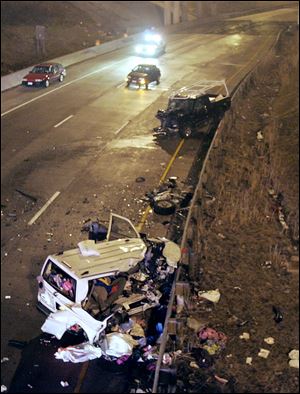
Agency proposes dropping drunk-driving limit to 0.05%
Local eateries,others slam ‘ludicrous’ idea
5/14/2013
Five members of a Maryland family were killed when their van was struck by a drunken wrong-way driver on I-280 in Toledo on Dec. 31, 2007.
Reducing the blood-alcohol level for legal driving to 0.05 percent, along with better detection and stricter enforcement, is needed to revive recent “relatively slow” progress in combating drunken-driving deaths and injuries, the National Transportation Safety Board said in a report it approved on Tuesday.
“Most Americans think that we’ve solved the problem of impaired driving, but in fact, it’s still a national epidemic,” said Deborah Hersman, the safety board’s chairman. “On average, every hour one person is killed and 20 more are injured.”
The NTSB report states that by 0.05 blood-alcohol content, also measured as grams per deciliter, research shows that “most drivers experience a decline in both cognitive and visual functions, which significantly increases the risk of a serious crash.”
More than 100 countries on six continents already have set blood-alcohol limits of 0.05 or below, the safety board noted, and the board “has asked all 50 states to do the same.”
The proposal got a hearty endorsement from the American Trucking Associations, whose industry’s drivers already must comply with a stricter, 0.04 BAC standard. But the response was tepid from Mothers Against Drunk Driving, whose Ohio executive director said the recommendations for stricter enforcement and development of detection technology are more in line with its current campaign.
Requiring ignition-interlock devices in the vehicles of all drivers convicted of drunken driving and advanced systems that would detect exhaled alcohol in vehicles would eliminate the vast majority of fatal alcohol-related crashes, said Doug Scoles, MADD leader in Columbus.
“We appreciate the NTSB’s efforts to raise awareness of drunken driving as a major problem on our nation’s roads,” Mr. Scoles said, but MADD is “neutral” on lowering the blood-alcohol threshold.
The safety board already had recommended requiring ignition-interlock devices for first-time drunken-driving convictions in a report it adopted in December concerning wrong-way crashes, for which intoxication is the leading cause.
Stronger state enforcement is needed because only one in four drivers ordered to use ignition interlocks, which require them to exhale into a tube before their cars will start, comply with those orders, the board said.
Ohio and Michigan currently allow courts to require ignition interlocks for first offenses, but only require it for repeat drunken drivers or, in Michigan’s case, those convicted with blood-alcohol contents of 0.17 or higher.
Previous efforts to combat drunken driving have reduced the United States’ annual alcohol-related death toll from 21,113 in 1982 to 9,878 in 2011, the safety board said, while the share of traffic fatalities involving alcohol has fallen from 48 percent to about 31 percent in that time.
But more needs to be done to address the rest, Ms. Hersman said. “Alcohol-impaired crashes are not accidents,” the board chairman said. “They are crimes. They can — and should — be prevented. The tools exist. What is needed is the will.”
Jerome Phillips, a prominent Toledo criminal-defense lawyer, predicted that any legislation to lower blood-alcohol limits would fail because of economic damage to the restaurant and bar industry and beer, wine, and liquor manufacturers.
States reduced the limit two decades ago from 0.10 to 0.08 only under the threat of losing their share of federal highway funds, and the scientific evidence to lower it further just isn’t there, Mr. Phillips said.
“They say this is to save lives. If you lower the speed limit, you’re going to save lives, but people don’t want to drive 40 miles [per hour] on the Turnpike,” he said, adding later, “I don’t see the federal government doing it in this case.”
A typical 180-pound male would approach the 0.08 threshold by drinking four 12-ounce beers, four 4-ounce glasses of wine, or four shots of 100-proof liquor. Cutting the limit to 0.05 would reduce that to “a little more than two drinks,” Mr. Phillips said.
Furthermore, he said, most of the drunken-driving cases in his practice involve people whose blood-alcohol was measured at 0.11 or higher.
“I can’t recall the last time I had a test reading between 0.05 and 0.08. They all pass the field sobriety tests” that police conduct before going to the Breathalyzer, Mr. Phillips said.
The safety board’s proposal got an immediate positive response from an organization of state highway safety officials.
“NTSB’s action raises the visibility of drunk driving and we will consider their recommendations,” said Jonathan Adkins of the Governors Highway Safety Association, while underscoring that the group continues to support the 0.08 level.
But it was denounced by a trade group for the alcoholic beverage and restaurant industries.
The American Beverage Institute said lawmakers and regulators would be better off focusing on highly intoxicated drivers and repeat offenders.
“This recommendation is ludicrous,” Sarah Longwell, the group’s managing director, said in an emailed statement. “Moving from 0.08 to 0.05 would criminalize perfectly responsible behavior. Further restricting the moderate consumption of alcohol by responsible adults prior to driving does nothing to stop hard-core drunken drivers from getting behind the wheel.”
“That would definitely begin to encroach on someone having just a glass or two of wine with dinner,” said Gus Mancy, a partner in the Mancy’s Restaurant Group, which operates four restaurants in the Toledo area.
Lowering the legal driving limit would, at the very least, cut into the number of customers ordering bottles of wine to share at meals, Mr. Mancy predicted.
Information from The Blade’s news services was used in this report.
Contact David Patch at: dpatch@theblade.com or 419-724-6094.